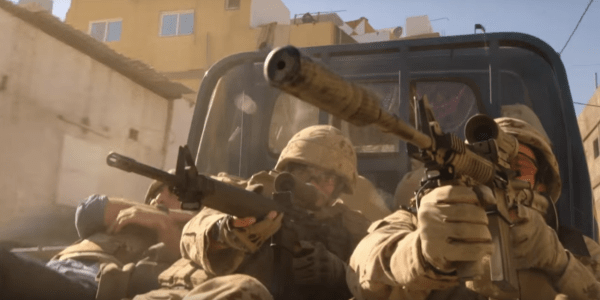

Translating the experiences of those who served in the Global War on Terror onto film has yielded mixed results, with many movies focusing on Iraq. The few that do take place in Afghanistan often focus on famous battles or special operations missions. However, the Canadian war drama “Hyena Road” aims to take a more fundamental look at the ground war in Afghanistan. Though the film’s take on asymmetric conflict stumbles along the way, it’s still worth seeing.
Directed and starring Paul Gross, who plays Capt. Pete Mitchell, the film was released in October 2015 and is set in the Panjwai district of Kandahar province. The road that lends its name to film is being constructed to allow Canadian forces to move troops and tanks to support isolated outposts against the Taliban. Canadian forces are working to finish the project with a local strongman, dubbed “BDK” and played by Fazal Hakimi, but the road is riddled with roadside bombs and the local construction crews are constantly targeted by the Taliban. Warrant Officer Ryan Sanders, played by Rossif Sutherland, leads a sniper section in Princess Patricia’s Canadian Light Infantry stationed at Forward Operating Base Sperwan Ghar. During an overwatch mission on the road, Sanders and his team are ambushed by the Taliban. They encounter a village elder who shelters them from the pursuing Taliban under the tribal Afghan code of Pashtunwali. Mitchell, an intelligence officer working in the tactical operation center, hears about the engagement and deduces that the elder is “the Ghost,” played by Neamat Arghandabi, a legendary mujahideen leader who vanished after the Soviets left Afghanistan. He has resurfaced to confront BDK, who alternates between moonlighting for the CIA and the Taliban.
What works best in “Hyena Road” are the opposite philosophies of war espoused by the two main characters. Mitchell prefers a population-focused approach, working with a network of contacts and local leaders to hasten the road’s construction. Sanders, being a sniper, naturally prefers eliminating the enemy fighters planting improvised explosive devices and conducting ambushes along Hyena Road. What’s interesting is how the film inverts the typical archetypes war films ascribe to these kinds of characters.
Despite his commitment to the counterinsurgency mission, Mitchell has a cynical mindset and justifies playing various groups against each other in order to give the Afghans a fighting chance at a better existence before Coalition troops must leave. Alternatively, Sanders views his profession as black and white: Engage targets, protect non-combatants. He also genuinely believes what his team does is important. For Sanders, being in the right place to shoot the right person could change the course of the war. The film illustrates the shifting layers of complexity: BDK plays all sides because he is motivated by personal gain rather than any sort of ideological association with the Afghan government; Mitchell wants to partner with the Ghost to ensure Hyena’s construction; but the Ghost seems more interested in using the Canadians to get at BDK. The conflict between the two Afghans is elemental, a personal confrontation that makes the broader picture of a stable Afghanistan seem distant, almost irrelevant. As Mitchell describes it: “It’s not one war, it’s a bunch of different wars.”
“Hyena Road” builds this heated atmosphere with its presentation. Much of the movie is augmented with B-roll and establishing shots of real Canadian bases and soldiers. While a bit jarring, ultimately it allows the film to achieve effective visuals rivaling Hollywood fare like “Lone Survivor” and “Zero Dark Thirty,” with the modest budget of 12.5 million. Footage of the sprawling Kandahar Airfield and the city itself, along with scenes of real helicopters dodging tracer fire all help to sell the movie’s vision of the “Graveyard of Empires.” Mitchell even invokes that moniker for Afghanistan in his narration throughout the film, referencing the experiences of Alexander the Great, the first to get caught in Afghanistan’s trap: “Alexander’s mother wrote him and said: I understand now: in Afghanistan, even the dirt is hostile.”
Related: A Hollywood military advisor explains how veterans can break into show biz »
The film adds realism with authentic uniforms and equipment, and of course, a few shots of soldiers playing street hockey and lining up at the Kandahar Tim Hortons for a little Canadian flavor. It also portrays the war as a multi-partner effort with Mitchell coordinating with Afghan police and army personnel, as well as enlisting the aid of a U.S. Army signals intelligence unit in one key scene.
Unfortunately, “Hyena Road” stumbles in a few key ways. Mitchell’s sniper team gets little characterization beyond cool sniper guys, which is a shame given there are some interesting opportunities to differentiate the Canadian soldiers And the single major female character is mired in the overused war movie trope of the officer-subordinate romance which feels overly forced in this particular story. A Canadian general has such histrionic dialogue in several scenes it became difficult to take him seriously.
In one scene, the general explains his mission to a group of Afghan officials by saying “I’m building a big fucking road, and it is going like a dagger into the heart of enemy, and it is fucking him up,”
Finally, the climax of the film fumbles, burying any reflection on the ambivalence of victory in Afghanistan in a sudden violent battle that just ushers in the ending without any real resolution. Despite these issues, “Hyena Road” is an admirable attempt to get at the more fundamental concepts at play in Afghanistan. For its efforts, it oftens feels more real than films attempting to recreate actual battles without any context.
“Hyena Road” may be the first of a more interrogative era of cinema about Iraq and Afghanistan, and for that it’s certainly worth a viewing.